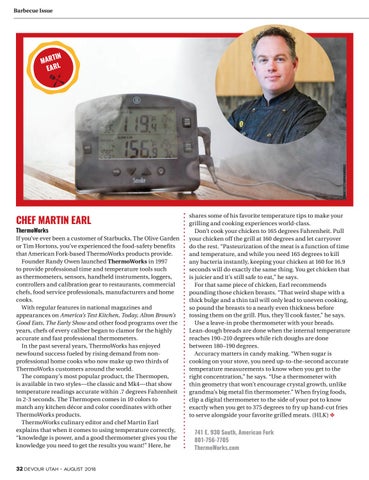Barbecue Issue
COURTESY THERMOWORKS
TIN M AR EARL
CHEF MARTIN EARL
ThermoWorks If you’ve ever been a customer of Starbucks, The Olive Garden or Tim Hortons, you’ve experienced the food-safety benefits that American Fork-based ThermoWorks products provide. Founder Randy Owen launched ThermoWorks in 1997 to provide professional time and temperature tools such as thermometers, sensors, handheld instruments, loggers, controllers and calibration gear to restaurants, commercial chefs, food service professionals, manufacturers and home cooks. With regular features in national magazines and appearances on America’s Test Kitchen, Today, Alton Brown’s Good Eats, The Early Show and other food programs over the years, chefs of every caliber began to clamor for the highly accurate and fast professional thermometers. In the past several years, ThermoWorks has enjoyed newfound success fueled by rising demand from nonprofessional home cooks who now make up two thirds of ThermoWorks customers around the world. The company’s most popular product, the Thermopen, is available in two styles—the classic and Mk4—that show temperature readings accurate within .7 degrees Fahrenheit in 2-3 seconds. The Thermopen comes in 10 colors to match any kitchen décor and color coordinates with other ThermoWorks products. ThermoWorks culinary editor and chef Martin Earl explains that when it comes to using temperature correctly, “knowledge is power, and a good thermometer gives you the knowledge you need to get the results you want!” Here, he
32 Devour Utah • AUGUST 2018
shares some of his favorite temperature tips to make your grilling and cooking experiences world-class. Don’t cook your chicken to 165 degrees Fahrenheit. Pull your chicken off the grill at 160 degrees and let carryover do the rest. “Pasteurization of the meat is a function of time and temperature, and while you need 165 degrees to kill any bacteria instantly, keeping your chicken at 160 for 16.9 seconds will do exactly the same thing. You get chicken that is juicier and it’s still safe to eat,” he says. For that same piece of chicken, Earl recommends pounding those chicken breasts. “That weird shape with a thick bulge and a thin tail will only lead to uneven cooking, so pound the breasts to a nearly even thickness before tossing them on the grill. Plus, they’ll cook faster,” he says. Use a leave-in probe thermometer with your breads. Lean-dough breads are done when the internal temperature reaches 190–210 degrees while rich doughs are done between 180–190 degrees. Accuracy matters in candy making. “When sugar is cooking on your stove, you need up-to-the-second accurate temperature measurements to know when you get to the right concentration,” he says. “Use a thermometer with thin geometry that won’t encourage crystal growth, unlike grandma’s big metal fin thermometer.” When frying foods, clip a digital thermometer to the side of your pot to know exactly when you get to 375 degrees to fry up hand-cut fries to serve alongside your favorite grilled meats. (HLK) ❖ 741 E. 930 South, American Fork 801-756-7705 ThermoWorks.com
